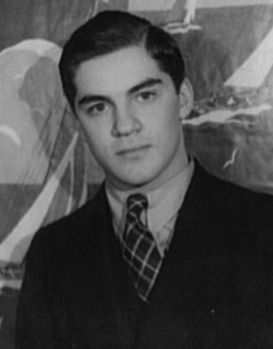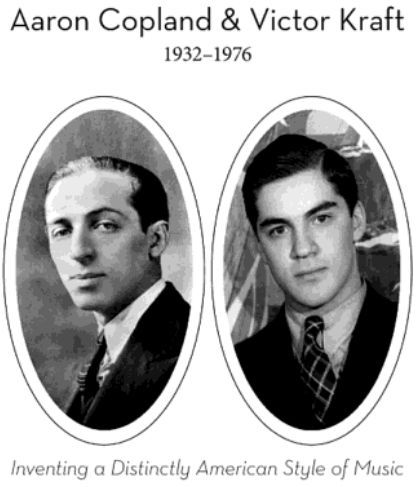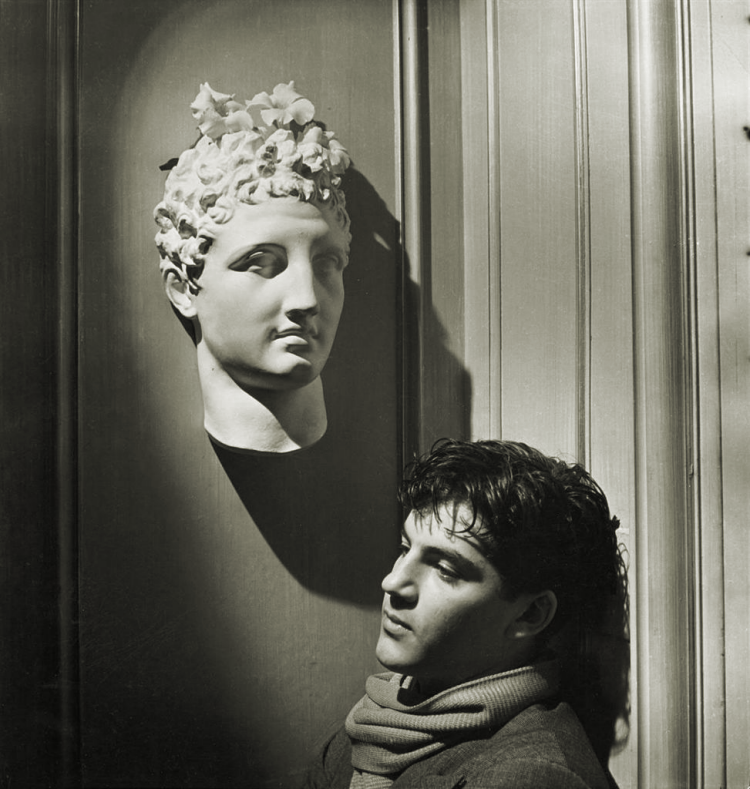Victor Kraft was born Victor Hugo Etler on August 8, 1915, in Oneonta, New York, the son of Samuel Etler (born in New York City) and Bella Kraftsov (emigrated from Alexandrovsk, Russia).
Kraft attended Public School 19 and DeWitt Clinton High School. He was a violinist prodigy and gave concerts as a child, later attending Juilliard School. He studied composition under Roger Sessions. He left music to pursue photography at the urging of Aaron Copland.
Kraft and Aaron Copland met in 1932, when Kraft was 16 years old, and had a close relationship until Kraft's death in 1976. Copland called Kraft his "pupil, companion, secretary and friend."
In 1936 Kraft studied photography at the Santuario de Ocotlan in Tlaxcala and from December 1936 to April 1937 he covered the Spanish Civil War as a photojournalist for Louis Aragon's Ce Soir
Victor Kraft contributed photographs to prominent publications like Life Magazine, Harper's Bazaar, Junior Bazaar, The New York Times, Look and the French art journal L'Oeil.
His portraits include, other than Aaron Copland, composers and performers of the American music scene, including Leonard Bernstein, Paul Bowles, Edwin Denby, Lukas Foss, Erik Johns, William Kapell, Dimitri Mitropoulos, and Robert Shaw.
He also documented the Tanglewood Music Festival in the 1940s.
During World War II he studied under Margaret Bourke-White and managed a concert tour for Prince George Chavchavadze. From 1945 to 1947 he worked for Harper's Bazaar, but he did not like it and was fired.
During all his career as photographer, Kraft was also paid by Copland to be his secretary and chauffeur, and they lived together at Bernardsville, Ridgefield, Sneden's Landing, Ossining and Cortlandt Manor. They also travelled to Bemidji, Hollywood, Mexico and Cuba.
A handsome man, with dark brown-hair and blue-gray eyes, Kraft posed for Cecil Beaton and Carl Van Vechten.
The relationship between Copland and Kraft remained unknown to the general public until Copland's death in 1990. When Bernstein urged an aging Copland to come out, Copland replied: "I think I'll leave that to you, boy."
Victor Kraft traveled in Mexico in the 1930s and in Brazil from 1951 to 1953.
In 1951 Kraft married Pearl Kazin, writer and sister of Alfred Kazin, a literary critic. The marriage lasted a few months. In 1960 Kraft married Rheba Robinson, a nurse. They moved to Croton-on-Hudson and Kraft found a house for Copland in near Cortlandt Manor. Copland was the godfather of Kraft's only child Jeremy Aaron, who was mentally handicapped. Kraft did not accept the situation and in 1968 he left his wife and took Jeremy with him, traveling around the world for eight years.
Kraft died of a heart attack on July 2, 1976, and Jeremy returned to live with his mother. When Copland died in 1990, he left $25,000 ($45,110.61 in 2017) to Jeremy's mother, "to be used for the support and maintenance of my godson, Jeremy Aaron Kraft", the larger sum he left aside from that to his secretary, David Walker.
Sources:
Pollack, Howard (2015). Aaron Copland: The Life & Work of an Uncommon Man. Henry Holt and Company. p. 238. Retrieved 10 September 2017.
"Victor Kraft Materials, 1918–1976". Retrieved 10 September 2017.
Harbin, Billy J.; Marra, Kim; Schanke, Robert A. (2005). The Gay & Lesbian Theatrical Legacy: A Biographical Dictionary of Major Figures in American Stage History in the Pre-Stonewall Era. University of Michigan Press. p. 102. Retrieved 10 September 2017.
"DollarTimes". Retrieved 23 September 2017.
~ Contributor: Elisa Rolle (48982101)∼Victor Kraft would prove to be the one constant romantic relationship in Aaron Copland's life.
Originally a student of music under Aaron Copland, Kraft gave up music in pursuit of a career in photography on Copland's urging. Kraft would leave and re-enter Copland's life, often bringing much stress with him: their relationship would fluctuate from contentedness to erratically confrontational on Kraft's part.
Kraft fathered a child to whom Copland later provided financial security, through a bequest from his estate.
Like many of his contemporaries he guarded his privacy, especially in regard to his homosexuality, providing very few written details about his private life. However, he was one of the few composers of his stature to live openly and travel with his intimates, most of whom were talented, much younger men.
Among Copland's love affairs, most of which lasted for only a few years yet became enduring friendships, were ones with photographer Victor Kraft, artist Alvin Ross, pianist Paul Moor, librettist Erik Johns, composer John Brodbin Kennedy, and painter Prentiss Taylor
Victor Kraft was born Victor Hugo Etler on August 8, 1915, in Oneonta, New York, the son of Samuel Etler (born in New York City) and Bella Kraftsov (emigrated from Alexandrovsk, Russia).
Kraft attended Public School 19 and DeWitt Clinton High School. He was a violinist prodigy and gave concerts as a child, later attending Juilliard School. He studied composition under Roger Sessions. He left music to pursue photography at the urging of Aaron Copland.
Kraft and Aaron Copland met in 1932, when Kraft was 16 years old, and had a close relationship until Kraft's death in 1976. Copland called Kraft his "pupil, companion, secretary and friend."
In 1936 Kraft studied photography at the Santuario de Ocotlan in Tlaxcala and from December 1936 to April 1937 he covered the Spanish Civil War as a photojournalist for Louis Aragon's Ce Soir
Victor Kraft contributed photographs to prominent publications like Life Magazine, Harper's Bazaar, Junior Bazaar, The New York Times, Look and the French art journal L'Oeil.
His portraits include, other than Aaron Copland, composers and performers of the American music scene, including Leonard Bernstein, Paul Bowles, Edwin Denby, Lukas Foss, Erik Johns, William Kapell, Dimitri Mitropoulos, and Robert Shaw.
He also documented the Tanglewood Music Festival in the 1940s.
During World War II he studied under Margaret Bourke-White and managed a concert tour for Prince George Chavchavadze. From 1945 to 1947 he worked for Harper's Bazaar, but he did not like it and was fired.
During all his career as photographer, Kraft was also paid by Copland to be his secretary and chauffeur, and they lived together at Bernardsville, Ridgefield, Sneden's Landing, Ossining and Cortlandt Manor. They also travelled to Bemidji, Hollywood, Mexico and Cuba.
A handsome man, with dark brown-hair and blue-gray eyes, Kraft posed for Cecil Beaton and Carl Van Vechten.
The relationship between Copland and Kraft remained unknown to the general public until Copland's death in 1990. When Bernstein urged an aging Copland to come out, Copland replied: "I think I'll leave that to you, boy."
Victor Kraft traveled in Mexico in the 1930s and in Brazil from 1951 to 1953.
In 1951 Kraft married Pearl Kazin, writer and sister of Alfred Kazin, a literary critic. The marriage lasted a few months. In 1960 Kraft married Rheba Robinson, a nurse. They moved to Croton-on-Hudson and Kraft found a house for Copland in near Cortlandt Manor. Copland was the godfather of Kraft's only child Jeremy Aaron, who was mentally handicapped. Kraft did not accept the situation and in 1968 he left his wife and took Jeremy with him, traveling around the world for eight years.
Kraft died of a heart attack on July 2, 1976, and Jeremy returned to live with his mother. When Copland died in 1990, he left $25,000 ($45,110.61 in 2017) to Jeremy's mother, "to be used for the support and maintenance of my godson, Jeremy Aaron Kraft", the larger sum he left aside from that to his secretary, David Walker.
Sources:
Pollack, Howard (2015). Aaron Copland: The Life & Work of an Uncommon Man. Henry Holt and Company. p. 238. Retrieved 10 September 2017.
"Victor Kraft Materials, 1918–1976". Retrieved 10 September 2017.
Harbin, Billy J.; Marra, Kim; Schanke, Robert A. (2005). The Gay & Lesbian Theatrical Legacy: A Biographical Dictionary of Major Figures in American Stage History in the Pre-Stonewall Era. University of Michigan Press. p. 102. Retrieved 10 September 2017.
"DollarTimes". Retrieved 23 September 2017.
~ Contributor: Elisa Rolle (48982101)∼Victor Kraft would prove to be the one constant romantic relationship in Aaron Copland's life.
Originally a student of music under Aaron Copland, Kraft gave up music in pursuit of a career in photography on Copland's urging. Kraft would leave and re-enter Copland's life, often bringing much stress with him: their relationship would fluctuate from contentedness to erratically confrontational on Kraft's part.
Kraft fathered a child to whom Copland later provided financial security, through a bequest from his estate.
Like many of his contemporaries he guarded his privacy, especially in regard to his homosexuality, providing very few written details about his private life. However, he was one of the few composers of his stature to live openly and travel with his intimates, most of whom were talented, much younger men.
Among Copland's love affairs, most of which lasted for only a few years yet became enduring friendships, were ones with photographer Victor Kraft, artist Alvin Ross, pianist Paul Moor, librettist Erik Johns, composer John Brodbin Kennedy, and painter Prentiss Taylor
Sponsored by Ancestry
Advertisement
Advertisement








